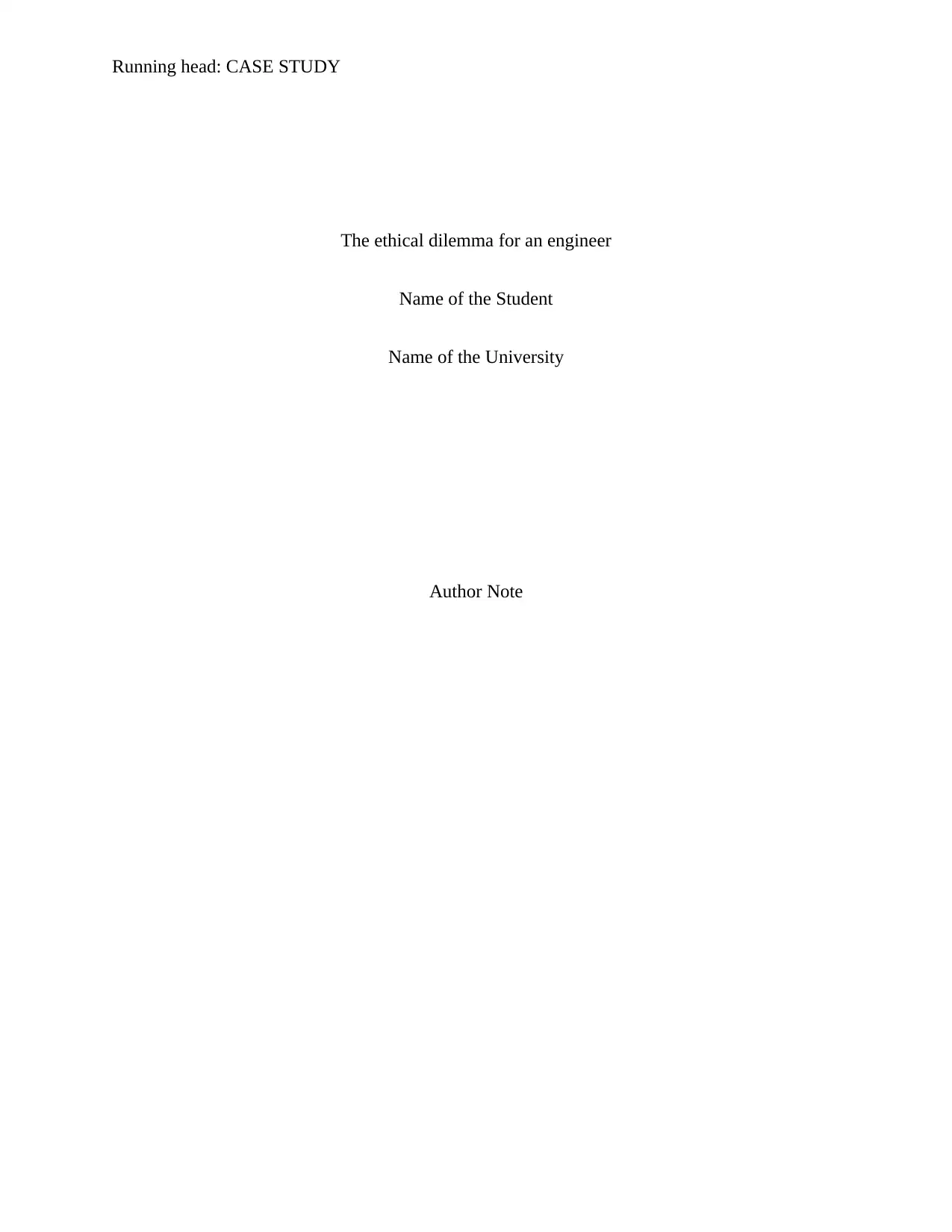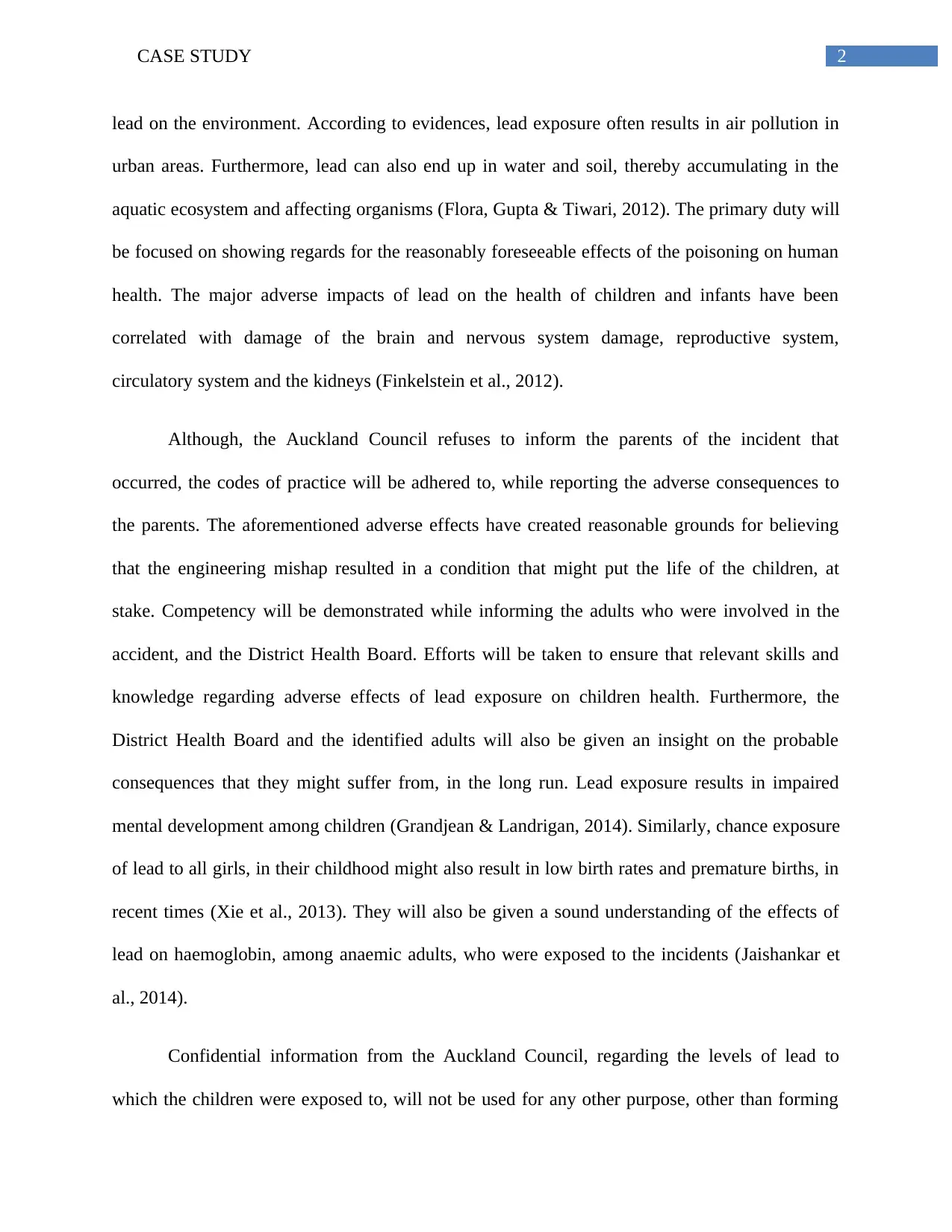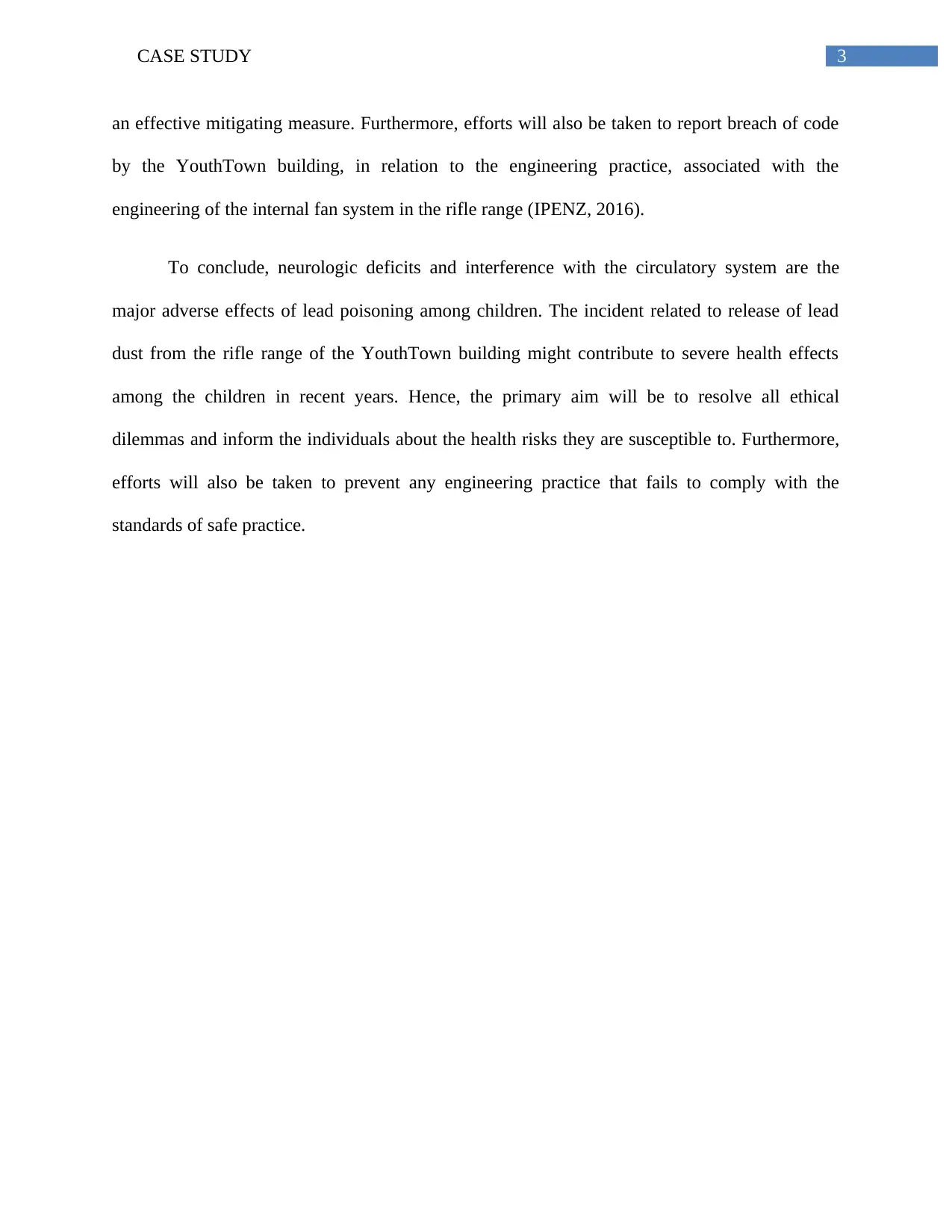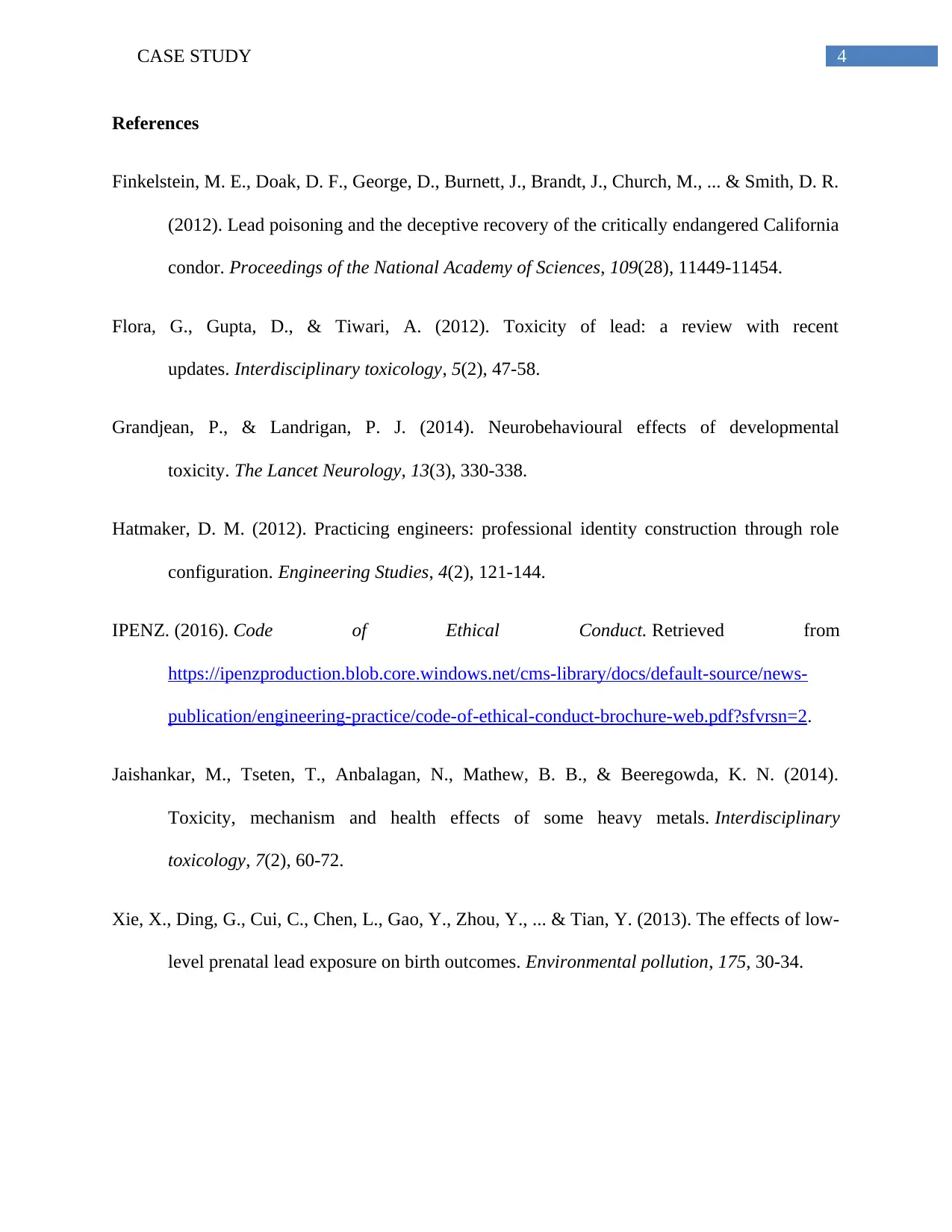ENGEN270 Ethics Case Study: Engineer's Ethical Role in Youthtown Lead
VerifiedAdded on 2023/06/12
|5
|1202
|473
Case Study
AI Summary
This case study examines the ethical responsibilities of an engineer confronted with lead contamination at the Youthtown building, focusing on the health risks to children exposed to lead dust. The engineer must navigate conflicting priorities from the Auckland Council, District Health Board, and Youthtown Board, all while adhering to the IPENZ code of ethics. The analysis emphasizes the engineer's duty to protect public health, report potential dangers, and ensure competent and ethical engineering practices, despite resistance from involved parties. The study highlights the long-term health consequences of lead exposure, including neurological deficits and developmental issues, underscoring the urgency of addressing the contamination and informing affected individuals. Desklib provides access to similar case studies and resources for students.

Running head: CASE STUDY
The ethical dilemma for an engineer
Name of the Student
Name of the University
Author Note
The ethical dilemma for an engineer
Name of the Student
Name of the University
Author Note
Paraphrase This Document
Need a fresh take? Get an instant paraphrase of this document with our AI Paraphraser

1CASE STUDY
Engineers have the responsibility of thinking ethically while working in a profession that
can affect the lives of several individuals, and the community as a whole. The major ethical roles
o an engineer include striking a balance between the environmental harms against the energy
needs of the society and conducting an assessment to evaluate the impact of the current political
and social priorities for developing engineering systems (Hatmaker, 2012). This essay will
illustrate the ethical considerations that must be taken into account, with respect to the pumping
of lead from the rifle range in the basement of the Youthtown building.
Lead poisoning is considered as a major public and environmental health hazard, of
global proportions. Adults and children, virtually in every region of the world are exposed to
levels of lead that are impermissible in the environment. Children are exposed to lead that comes
from different sources, such as, gasoline, paint, and solder. The adverse effects of lead on the
overall health and wellbeing of children can be attributed to high levels of exposure or
cumulative effects of repeated low or high level exposures (Jaishankar et al., 2014). The incident
of lead leakage that occurred from the rifle range located in the basement of the building can be
considered extremely dangerous, due to the fact that lead remains the environment for longer
periods of time (Finkelstein et al., 2012). Moreover, confined spaces or other regions that have
been contaminated with lead dust, due to some renovation, might result in lead poisoning among
children, several years later.
Efforts will be taken to adhere to the IPENZ code of ethics, while taking necessary steps
that would reduce the potential health harms of lead exposure on the children (now adults), living
in that region. Following the first standards, reasonable steps will be taken to safeguard the
health of the residents, who form the vulnerable population, thereby enhancing their safety
(IPENZ, 2016). Professional duties shall be conducted while showing regards to the effects of
Engineers have the responsibility of thinking ethically while working in a profession that
can affect the lives of several individuals, and the community as a whole. The major ethical roles
o an engineer include striking a balance between the environmental harms against the energy
needs of the society and conducting an assessment to evaluate the impact of the current political
and social priorities for developing engineering systems (Hatmaker, 2012). This essay will
illustrate the ethical considerations that must be taken into account, with respect to the pumping
of lead from the rifle range in the basement of the Youthtown building.
Lead poisoning is considered as a major public and environmental health hazard, of
global proportions. Adults and children, virtually in every region of the world are exposed to
levels of lead that are impermissible in the environment. Children are exposed to lead that comes
from different sources, such as, gasoline, paint, and solder. The adverse effects of lead on the
overall health and wellbeing of children can be attributed to high levels of exposure or
cumulative effects of repeated low or high level exposures (Jaishankar et al., 2014). The incident
of lead leakage that occurred from the rifle range located in the basement of the building can be
considered extremely dangerous, due to the fact that lead remains the environment for longer
periods of time (Finkelstein et al., 2012). Moreover, confined spaces or other regions that have
been contaminated with lead dust, due to some renovation, might result in lead poisoning among
children, several years later.
Efforts will be taken to adhere to the IPENZ code of ethics, while taking necessary steps
that would reduce the potential health harms of lead exposure on the children (now adults), living
in that region. Following the first standards, reasonable steps will be taken to safeguard the
health of the residents, who form the vulnerable population, thereby enhancing their safety
(IPENZ, 2016). Professional duties shall be conducted while showing regards to the effects of

2CASE STUDY
lead on the environment. According to evidences, lead exposure often results in air pollution in
urban areas. Furthermore, lead can also end up in water and soil, thereby accumulating in the
aquatic ecosystem and affecting organisms (Flora, Gupta & Tiwari, 2012). The primary duty will
be focused on showing regards for the reasonably foreseeable effects of the poisoning on human
health. The major adverse impacts of lead on the health of children and infants have been
correlated with damage of the brain and nervous system damage, reproductive system,
circulatory system and the kidneys (Finkelstein et al., 2012).
Although, the Auckland Council refuses to inform the parents of the incident that
occurred, the codes of practice will be adhered to, while reporting the adverse consequences to
the parents. The aforementioned adverse effects have created reasonable grounds for believing
that the engineering mishap resulted in a condition that might put the life of the children, at
stake. Competency will be demonstrated while informing the adults who were involved in the
accident, and the District Health Board. Efforts will be taken to ensure that relevant skills and
knowledge regarding adverse effects of lead exposure on children health. Furthermore, the
District Health Board and the identified adults will also be given an insight on the probable
consequences that they might suffer from, in the long run. Lead exposure results in impaired
mental development among children (Grandjean & Landrigan, 2014). Similarly, chance exposure
of lead to all girls, in their childhood might also result in low birth rates and premature births, in
recent times (Xie et al., 2013). They will also be given a sound understanding of the effects of
lead on haemoglobin, among anaemic adults, who were exposed to the incidents (Jaishankar et
al., 2014).
Confidential information from the Auckland Council, regarding the levels of lead to
which the children were exposed to, will not be used for any other purpose, other than forming
lead on the environment. According to evidences, lead exposure often results in air pollution in
urban areas. Furthermore, lead can also end up in water and soil, thereby accumulating in the
aquatic ecosystem and affecting organisms (Flora, Gupta & Tiwari, 2012). The primary duty will
be focused on showing regards for the reasonably foreseeable effects of the poisoning on human
health. The major adverse impacts of lead on the health of children and infants have been
correlated with damage of the brain and nervous system damage, reproductive system,
circulatory system and the kidneys (Finkelstein et al., 2012).
Although, the Auckland Council refuses to inform the parents of the incident that
occurred, the codes of practice will be adhered to, while reporting the adverse consequences to
the parents. The aforementioned adverse effects have created reasonable grounds for believing
that the engineering mishap resulted in a condition that might put the life of the children, at
stake. Competency will be demonstrated while informing the adults who were involved in the
accident, and the District Health Board. Efforts will be taken to ensure that relevant skills and
knowledge regarding adverse effects of lead exposure on children health. Furthermore, the
District Health Board and the identified adults will also be given an insight on the probable
consequences that they might suffer from, in the long run. Lead exposure results in impaired
mental development among children (Grandjean & Landrigan, 2014). Similarly, chance exposure
of lead to all girls, in their childhood might also result in low birth rates and premature births, in
recent times (Xie et al., 2013). They will also be given a sound understanding of the effects of
lead on haemoglobin, among anaemic adults, who were exposed to the incidents (Jaishankar et
al., 2014).
Confidential information from the Auckland Council, regarding the levels of lead to
which the children were exposed to, will not be used for any other purpose, other than forming
⊘ This is a preview!⊘
Do you want full access?
Subscribe today to unlock all pages.

Trusted by 1+ million students worldwide

3CASE STUDY
an effective mitigating measure. Furthermore, efforts will also be taken to report breach of code
by the YouthTown building, in relation to the engineering practice, associated with the
engineering of the internal fan system in the rifle range (IPENZ, 2016).
To conclude, neurologic deficits and interference with the circulatory system are the
major adverse effects of lead poisoning among children. The incident related to release of lead
dust from the rifle range of the YouthTown building might contribute to severe health effects
among the children in recent years. Hence, the primary aim will be to resolve all ethical
dilemmas and inform the individuals about the health risks they are susceptible to. Furthermore,
efforts will also be taken to prevent any engineering practice that fails to comply with the
standards of safe practice.
an effective mitigating measure. Furthermore, efforts will also be taken to report breach of code
by the YouthTown building, in relation to the engineering practice, associated with the
engineering of the internal fan system in the rifle range (IPENZ, 2016).
To conclude, neurologic deficits and interference with the circulatory system are the
major adverse effects of lead poisoning among children. The incident related to release of lead
dust from the rifle range of the YouthTown building might contribute to severe health effects
among the children in recent years. Hence, the primary aim will be to resolve all ethical
dilemmas and inform the individuals about the health risks they are susceptible to. Furthermore,
efforts will also be taken to prevent any engineering practice that fails to comply with the
standards of safe practice.
Paraphrase This Document
Need a fresh take? Get an instant paraphrase of this document with our AI Paraphraser

4CASE STUDY
References
Finkelstein, M. E., Doak, D. F., George, D., Burnett, J., Brandt, J., Church, M., ... & Smith, D. R.
(2012). Lead poisoning and the deceptive recovery of the critically endangered California
condor. Proceedings of the National Academy of Sciences, 109(28), 11449-11454.
Flora, G., Gupta, D., & Tiwari, A. (2012). Toxicity of lead: a review with recent
updates. Interdisciplinary toxicology, 5(2), 47-58.
Grandjean, P., & Landrigan, P. J. (2014). Neurobehavioural effects of developmental
toxicity. The Lancet Neurology, 13(3), 330-338.
Hatmaker, D. M. (2012). Practicing engineers: professional identity construction through role
configuration. Engineering Studies, 4(2), 121-144.
IPENZ. (2016). Code of Ethical Conduct. Retrieved from
https://ipenzproduction.blob.core.windows.net/cms-library/docs/default-source/news-
publication/engineering-practice/code-of-ethical-conduct-brochure-web.pdf?sfvrsn=2.
Jaishankar, M., Tseten, T., Anbalagan, N., Mathew, B. B., & Beeregowda, K. N. (2014).
Toxicity, mechanism and health effects of some heavy metals. Interdisciplinary
toxicology, 7(2), 60-72.
Xie, X., Ding, G., Cui, C., Chen, L., Gao, Y., Zhou, Y., ... & Tian, Y. (2013). The effects of low-
level prenatal lead exposure on birth outcomes. Environmental pollution, 175, 30-34.
References
Finkelstein, M. E., Doak, D. F., George, D., Burnett, J., Brandt, J., Church, M., ... & Smith, D. R.
(2012). Lead poisoning and the deceptive recovery of the critically endangered California
condor. Proceedings of the National Academy of Sciences, 109(28), 11449-11454.
Flora, G., Gupta, D., & Tiwari, A. (2012). Toxicity of lead: a review with recent
updates. Interdisciplinary toxicology, 5(2), 47-58.
Grandjean, P., & Landrigan, P. J. (2014). Neurobehavioural effects of developmental
toxicity. The Lancet Neurology, 13(3), 330-338.
Hatmaker, D. M. (2012). Practicing engineers: professional identity construction through role
configuration. Engineering Studies, 4(2), 121-144.
IPENZ. (2016). Code of Ethical Conduct. Retrieved from
https://ipenzproduction.blob.core.windows.net/cms-library/docs/default-source/news-
publication/engineering-practice/code-of-ethical-conduct-brochure-web.pdf?sfvrsn=2.
Jaishankar, M., Tseten, T., Anbalagan, N., Mathew, B. B., & Beeregowda, K. N. (2014).
Toxicity, mechanism and health effects of some heavy metals. Interdisciplinary
toxicology, 7(2), 60-72.
Xie, X., Ding, G., Cui, C., Chen, L., Gao, Y., Zhou, Y., ... & Tian, Y. (2013). The effects of low-
level prenatal lead exposure on birth outcomes. Environmental pollution, 175, 30-34.
1 out of 5
Your All-in-One AI-Powered Toolkit for Academic Success.
+13062052269
info@desklib.com
Available 24*7 on WhatsApp / Email
![[object Object]](/_next/static/media/star-bottom.7253800d.svg)
Unlock your academic potential
Copyright © 2020–2025 A2Z Services. All Rights Reserved. Developed and managed by ZUCOL.